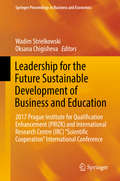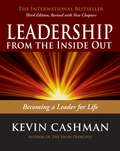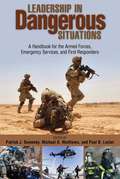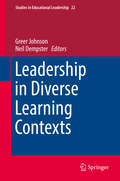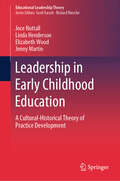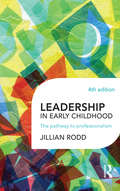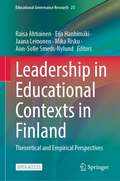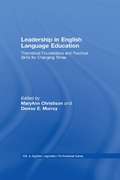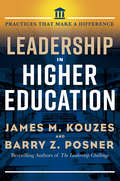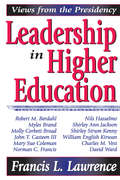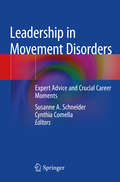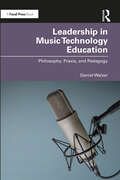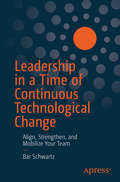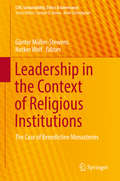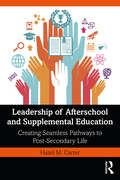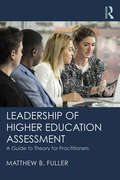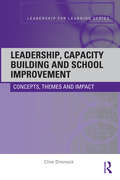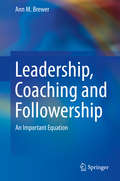- Table View
- List View
Leadership for an Age of Wisdom
by Chris BransonThis book provides a clear, comprehensive, and compelling description of the nature, characteristics, and prerequisites of wisdom-led leadership. It not only includes a detailed description of what is meant by wisdom-led leadership but also it describes how wisdom-led leadership can be developed based on current research data. In other words, practical ways to promote wisdom-led leadership are described. In addition, a metaphysical foundation in support of wisdom-led leadership is provided along with a detailed analysis of how this form of leadership can better prepare the leader to confidently and capably attend to their relational and organisational development demands, which are pivotal to their success. Finally, the fundamentally important and influential external issues of performance management, vision, goals, and accountability are discussed at length with respect to their potentially detrimental impact on the achievement of wisdom-led leadership. Embracing wisdom-led leadership does not mean that we have to forgo what performance management, vision, goals, and accountability procedures seek to achieve. It just means that these desired outcomes need to be achieved differently.
Leadership for the Future Sustainable Development of Business and Education: 2017 Prague Institute For Qualification Enhancement (prizk) And International Research Centre (irc) Scientific Cooperation International Conference (Springer Proceedings In Business And Economics)
by Wadim Strielkowski Oksana ChigishevaThis proceedings volume examines leadership from the perspectives of business, economics, social sciences, cross-cultural management, and education as a means to establish a future of sustainable development. Featuring contributions from the 2017 Prague Institute for Qualification Enhancement (PRIZK) and International Research Centre (IRC) “Scientific Cooperation” International Conference held in the Czech Republic, this volume focuses particularly on business models and higher education schemes from BRICS nations and examines topics such as social and educational practices, academic policies and business development. Leadership is becoming a key element for the future sustainable development of business and education in the quickly globalizing world. In this regard, a special emphasis should be made on the formation of high-quality human resources—the leading experts in their field who will create innovations and introduce breakthrough technologies. The development of a creative economy and knowledge economy requires highly-educated human capital, thus education becomes a key element of this process. Education must keep pace with time, be competitive, and stay in touch with the process of technology. The enclosed papers identify the key steps for sustainable growth and development in business and education. Featuring contributions on theory and practice, this book is appropriate for academics, researchers, policy-makers and practitioners in the areas of business, leadership management, entrepreneurship, innovation and education.
Leadership from the Inside Out: Becoming a Leader for Life
by Kevin CashmanThis classic bestseller by Kevin Cashman pioneered a holistic approach to leadership development: grow the whole person to grow the whole leader. The third edition turns leadership development inside out for a new generation of authentic, purpose-inspired leaders.This book was the first to reveal and build on a foundational insight: we lead by virtue of who we are. Cashman's trademark whole-person approach is essential to success in today's talent-starved marketplace and provides a measurable return on investment. Framed in seven simple yet profound personal mastery areas, this book serves as an integrated coaching experience that helps leaders understand how to harness their authentic, value-creating influence and elevate their impact as individuals, in teams, and in organizations. The third edition contains updated content in the first three chapters-Personal Mastery, Purpose Mastery, and Interpersonal Mastery (the most foundational chapters in the book)-and includes a new chapter, Story Mastery: Leading with Inspiration. This chapter deepens comprehension of authenticity, provides a more significant sense of meaning and purpose, and inspires more profound interpersonal connection. For everyone from CEOs to emerging leaders, this long-awaited third edition advances the art and science of leadership, which makes the book even more relevant today than when it was first published.
Leadership in America's Best Urban Schools
by Cynthia L. Uline Joseph F. Johnson, Jr. Lynne G. PerezLeadership in America’s Best Urban Schools describes and demystifies the qualities that successful leaders rely on to make a difference at all levels of urban school leadership. Grounded in research, this volume reveals the multiple challenges that real urban elementary, middle, and high schools face as well as the catalysts for improvement. This insightful resource explores the critical leadership characteristics found in high-performing urban schools and gives leaders the tools to move their schools to higher levels of achievement for all students—but especially for those who are low-income, English-language learners, and from various racial and ethnic backgrounds. In shining a light on the essential qualities for exceptional leadership at all levels of urban schools, this book is a valuable guide for all educators and administrators to nurture, influence, support, and sustain excellence and equity at their schools.
Leadership in Dangerous Situations
by Patrick Sweeney Michael D. Matthews Paul B. LesterLeadership in Dangerous Situations provides in-depth coverage of the key psychological, social and organization factors that impact individual and organizational effectiveness for First Responders in dangerous environments. Leading scholars discuss how current theories and empirical research provides guidelines to help solve the challenges leaders are likely to face in dangerous contexts. This book is directed to First Responders leaders from the Military, Law Enforcement, Fire, Emergency Services and Not-for profit agencies working in dangerous areas. The purpose of this book is to assist the First Responders who risk their lives to serve the public, to prepare for the unique challenges of leading and operating in dangerous situations. Dangerous situations are environments where group members must routinely engage in events that place their physical and psychological well-being at risk to accomplish the organization's objectives. International scholars and practitioners from the military, law enforcement, fire and rescue, teamed together to address the unique challenges facing dangerous context leaders. Each chapter integrates theory and research with practical experience to address the various challenges these leaders will face while operating in dangerous situations. The intent is to provide practitioners an easily understandable guide, backed by scholarly findings, to prepare themselves and their organizations for the unique psychological, social, and physical challenges of leading and operating in dangerous contexts. The blending of theory and empirical research with practical experience clearly illustrates the principles of effective leadership in dangerous contexts Whether one is a young leader preparing for war, a seasoned commander with multiple combat tours, a Special Weapons and Tactics (SWAT) team leader, Emergency Medical Technician (EMT) supervisor, first line supervisor of a law enforcement patrol unit, or a lieutenant responsible for a shift of firemen, the challenges of leading people in contexts where life and death decisions are common are very similar. The purpose here is to provide the leader with a better understanding of what is required to lead in dangerous contexts. The contributing authors delve into the psychological, social, and physical factors that can impact the ability to lead, the ability of personnel to perform, and the organization's ability to accomplish the mission. In the end, the leader will take away not only a understanding of how leading in dangerous contexts is different than leading in contexts where lives are not on the line, but also gain a deeper understanding of why it differs, where commonalities occur, and - perhaps more importantly - how to prepare leaders, whether military or civilian to guide their first responder organizations to perform successfully in dangerous situations.
Leadership in Diverse Learning Contexts
by Greer Johnson Neil DempsterThis book presents the outcomes of research and practical endeavour in some of the diverse contexts in which learning takes place: classrooms, schools, professional development settings, community projects and service sector agencies. It invites the reader to engage with two related questions of contemporary concern in the leadership field: "What can we learn about the important influence of different contexts on leadership practice and how are people brought together as collective human agents in different patterns of distributive leadership?" In doing so, this collection emphasises three of the critical concepts at play when leadership is viewed, not as position, but as activity. The three concepts are purpose, context and human agency. When this view of leadership is understood, it is always about achieving shared goals with people power, no matter the circumstances in which they are gathered together.
Leadership in Early Childhood Education: A Cultural-Historical Theory of Practice Development (Educational Leadership Theory)
by Elizabeth Wood Jenny Martin Joce Nuttall Linda HendersonThe book presents a conceptual framework for understanding leadership for effective educator learning in early childhood settings. The book describes how leaders can move centre practices from crisis to stabilization. It argues that a core component of leaders' work in early childhood settings is to construct and enact epistemological accounts of practice change. The book includes case examples that bring to life the contexts early childhood services and services leaders who participated in the research. The book also describes the application of cultural-historical activity theory to the development of practice in early childhood education. It describes how background theory, literature, and data can be synthesized to create new focal theory in education. Readers will benefit from the theory that is presented, establishing a sound basis for testing in future research in schools as well as in early childhood education. “Joce Nuttall and team are congratulated for their ground-breaking scholarly endeavour in designing, implementing, validating findings, and then writing a book that unambiguously connects theory-policy-practice in enacting leadership in early childhood settings. This book is ambitious, eloquent, and inspirational. The research was driven by a bold vision to build a new theorisation of early childhood leadership. The writing style of the book makes the complex clear and easy to digest, and thereby strengthening its readability and understanding. The comparative lens adopted in the study, underscores the neoliberal control of the working lives of early childhood leaders in both Australia and England. The use of case study narratives to explain various aspects including the study design and methodology, was refreshingly engaging. Notes of encouragement addressed to novice researchers such as those embarking on higher degree studies, also provide apt guidance about the messiness of conducting qualitative research. The book is infused with lots of examples demonstrating the transformative power of learning – especially when expertly scaffolded by the research team, and thereby increasing practitioner agency and quality improvement across the early childhood setting. If professional autonomy is the driver of reform and change, then we must find ways to nurture strong educational leaders who can think outside the box. Overall, Nuttall and team succeed in arousing learning-rich possibilities for reimagining early childhood leadership in theory and in practice, and thereby making a magnificent contribution to the scholarship of educational leadership.” Professor Manjula Waniganayake PhD, Macquarie University, Sydney, Australia
Leadership in Early Childhood: The pathway to professionalism
by Jillian Rodd'Essential reading and a powerful tool for emerging early childhood leaders.' - Catharine Hydon, Early Childhood ConsultantWith increasing community insistence for quality and accountability in early childhood education and care, there is a need for effective and professional leadership in these services. Leadership in Early Childhood is a practical resource for early childhood practitioners who want to understand how to create and sustain successful childcare and early education settings.Fully revised and updated, this fourth edition is divided into three sections: deconstructing leadership; leadership in practice; and special responsibilities of early childhood leaders. This edition also includes new case studies, an additional chapter summarising the key contributing factors to effective leadership and examples based on an extensive international study of early childhood leaders.Leadership in Early Childhood has been widely used in early childhood education programs and as a professional reference text and remains a valuable resource for both students and professionals.
Leadership in Education: From The Top Down And The Bottom Up (Centre for Educational Leadership and Management)
by Robert Smith Neil Burton Mark Brundrett`Leadership in education is receiving increasing attention, and this text contributes much to the debate. A useful text that will appeal to a wide audience of senior managers, teachers, programme designers and researchers′ - Learning and Skills Research `If one were on a fact-finding mission to gain insight into leadership thought and practice in education, then this book is an excellent resource′ - Education News `This book makes an excellent contribution to the current debate on Educational Leadership. It blends theory with practice and provides an important resource for many aspects of leadership development programmes at a variety of levels. The book will appeal to the academic reader, the postgraduate student and those involved in providing leadership courses at a professional level. There is an international perspective on the analysis of leadership theory and practice, integrating examples from a variety of cultural settings and exploring education at all phases from primary to higher′ - Stephen Merrill, Edge Hill College of Higher Education, Journal of In-Service Education `Leadership in Education offers an excellent analysis of the current debate: well informed on research and practice, positive but critical. It is particularly strong on what it calls "the railway-bookstall offerings of context-independent leadership"…. There is a great deal of practical wisdom within these very accessible pages′ - Michael Duffy, Times Educational Supplement This book deals with leadership in all sectors, from primary to higher education. It presents an international perspective on the analysis of leadership theory and practice, with the integration of exemplars from different cultural settings. The authors provide a wide range of conceptual perspectives on leadership. Themes include: - the efficacy of centralized versus distributed concepts of leadership - the contrast between competency and academic models of leadership development - the contradistinction between functionalist and democratic models of leadership. These themes are developed in four sections: - Conceptualization - Leadership development - Teachers as leaders - Leadership in practice Contributors include: Clive Dimmock, Peter Gronn, Marianne Coleman, Peter Ribbins, Ray Bolam, Peter Newton, Kenneth Leithwood, Helen Gunter, Lynn Davis, Clive Harber and Graham Peeke This book is recommended to all involved in educational management, particularly to students, teachers, researchers, policy makers and educational administrators. The Centre for Educational Leadership and Management series, edited by Tony Bush, examines the impact of the many changes in the management of schools and colleges, drawing on empirical evidence. The approach if analytical rather than descriptive and generates conclusions about the most effective ways of managing schools on the basis of research evidence.
Leadership in Educational Contexts in Finland: Theoretical and Empirical Perspectives (Educational Governance Research #23)
by Raisa Ahtiainen Eija Hanhimäki Jaana Leinonen Mika Risku Ann-Sofie Smeds-NylundThis open access book provides a comprehensive overview and in-depth coverage of contemporary aspects of leadership in the field of education in Finland. It brings together Finnish scholars to critically explore and discuss leadership in education in the context of the Finnish education system and in relation to international discourses around the topic. It discusses the phenomenon of leadership in educational contexts through several novel empirical and theoretical research designs. It includes themes such as distributed leadership and collaborative governance, changing aspects in the leadership profession, and contradictions in everyday organizational practices and realities. The work also combines conceptual discussions in educational and pedagogical leadership to analyze and to clarify the theoretical and conceptual multidimensionality and ambiguities.
Leadership in English Language Education: Theoretical Foundations and Practical Skills for Changing Times (ESL & Applied Linguistics Professional Series)
by MaryAnn Christison Denise E. MurrayLeadership in English Language Education: Theoretical Foundations and Practical Skills for Changing Times presents both theoretical approaches to leadership and practical skills leaders in English language education need to be effective. Discussing practical skills in detail, and providing readers with the opportunity to acquire new skills and apply them in their own contexts, the text is organized around three themes: The roles and characteristics of leaders Skills for leading ELT leadership in practice Leadership theories and approaches from business and industry are applied to and conclusions are drawn for English language teaching in a variety of organizational contexts, including intensive English programs in English-speaking countries, TESOL departments in universities, ESL programs in community colleges, EFL departments in non-English speaking countries, adult education programs, and commercial ELT centers and schools around the world. This is an essential resource for all administrators, teachers, academics, and teacher candidates in English language education.
Leadership in Higher Education: Practices That Make A Difference
by Barry Posner Jim KouzesThe authors of the classic bestseller The Leadership Challenge bring their expertise to higher education, offering five practices that can make any college or university leader into an exemplary leader. Drawing on the same pioneering research that formed the foundation of their classic bestseller The Leadership Challenge (over 2.7 million copies sold), James Kouzes and Barry Posner offer a set of leadership skills and practices that will make a significant difference in every area of higher education—faculty, administration, library services, career counseling, auxiliary services, campus safety, and more. It's about the behaviors that leaders, regardless of their position, use to transform values into actions, visions into realities, obstacles into innovations, segments into solidarity, and risks into rewards. Kouzes and Posner tell the leadership story from the inside and move outward, describing it first as a personal journey and then as mobilizing others to want to do things they have never done before. The Five Practices of Exemplary Leadership is the operating system for this adventure. Leadership in Higher Education explains the fundamental principles that support these practices and provides case examples of people in higher education who demonstrate each one. A core theme that weaves its way through all the chapters is that, whether it's one to one or one to many, leadership is a relationship between those who aspire to lead and those who choose to follow. We need leaders who can unite us and ignite us. This book lights the way.
Leadership in Higher Education: Views from the Presidency
by Francis L. LawrenceIn this collection of interviews, presidents and chancellors of some of America's most respected universities candidly reflect on their experiences during the decade leading up to the twenty-first century and immediately following it. This was a time of change and uncertainty, when opportunities for achievement and potential for failure made their role uncommonly challenging, and success called for considerable determination, integrity, foresight, skill, and courage.The American higher education system, often characterized as the best in the world, is distinguished for its scholarship as well as its accessibility. Its indispensable role as an engine for individual and societal economic advancement has made universities the targets of media interest, critical examination, and political manipulation. Higher education has become the passport to the American dream, and the percentage of those going to college has increased, challenging individual institutions and systems to accommodate growing numbers of aspiring students while searching for solutions to problems of inadequate college preparation and inadequate financial assistance for low-income students. Despite their increasing importance to the nation, the region, and their communities, public and private universities have seen states reduce their support to their state systems of higher education, shifting the responsibility to individuals and institutions.Leadership in Higher Education traces the careers of thirteen women and men who have presided over a total of twenty universities or university systems and three national organizations of higher education: Robert Berdahl, Myles Brand, Molly Corbett Broad, John T. Casteen III, Mary Sue Coleman, Norman C. Francis, Nils Hasselmo, Shirley Ann Jackson, Shirley Strum Kenny, William English Kirwan, Francis L. Lawrence, Charles M. Vest, and David Ward.
Leadership in Movement Disorders: Expert Advice and Crucial Career Moments
by Cynthia Comella Susanne A. SchneiderThis book provides insights into the meaningful milestones of leaders and world experts in the field of movement disorders/neurology. Through the format of interview questions, it communicates the skills of key leaders in movement disorders. The interviewees are past and present leaders of the International Parkinson and Movement Disorders Society (IPMDS), which has grown from a young society into a strong successful organization. Their experiences reflect the nature of working in the global environment and diversity of this Society. The stories in this book have value that transcends a specific Society and will provide lessons in leadership that have application to many organizations around the world. This is a key resource for movement disorders experts, clinicians, scientists and young neurologists who are planning the next step in their career. It is also of interest to organizations who are facing the task of engaging and leading an international group of diverse participants.
Leadership in Music Technology Education: Philosophy, Praxis, and Pedagogy
by Daniel WalzerLeadership in Music Technology Education examines the pedagogical, sociocultural, and philosophical issues that affect curriculum, research, and decision-making in music technology in higher education. This book considers a range of cutting-edge topics, including the impact of the COVID-19 pandemic, professional development concepts, partnerships between higher education and the creative and cultural industries, and the effects technology has on sustainability. Drawing on Leadership theories, including Transformational, Situational, Servant, and Social Change Model Theory, the book puts forward a new model, Creative Industry Leadership, which considers the sociocultural aspects of Music Technology Education, and interrogates biased ideologies that limit opportunities for a broad range of learners and practitioners in education and beyond. Additionally, Leadership in Music Technology Education examines educators’ informal leadership capacities during the COVID-19 pandemic and how inclusive pedagogy expands the creative boundaries of teaching, learning, and music-making for all. Leadership in Music Technology Education is crucial reading for instructors teaching audio engineering and music technology, as well as researchers in education, music pedagogy and related fields. This is also a valuable read for anyone with an interest in music technology and its many potentialities.
Leadership in New Working Environments: Realizing the Potential of Flexible Workplace Concepts (Business Guides on the Go)
by Sandra GauerThis book discusses the challenges that modern and flexible workplace concepts pose for managers. In particular, it addresses the uncertainties and stress factors that employees face when working in multi-space environments and how they become attached to their workplace. Drawing on a hybrid methodological approach that combines a literature review with practical lessons learned as a workplace change consultant, it offers managers concrete advice on how to lead in multi-space environments. This book aims to reduce the uncertainties and stressors caused by new work environments, and ideally to transform them into growth opportunities for the entire company. Providing concrete solutions, it represents a valuable asset for managers, HR professionals, and workplace initiative leaders alike.
Leadership in Post-Compulsory Education: Inspiring Leaders of the Future
by Jill JamesonLeadership of different kinds exists at many levels in the post-compulsory sector-from principles to programme leaders, administrative staff and even caretakers. Based around case studies of current leaders in post-compulsory education, this unique book explores a number of leadership models and styles in order to provide inspiration and guidance for the next wave of potential leaders. * Captures authentic "voices of the leaders" * Includes examples of further, adult, community and prison education * Covers all type of leadership: charismatic leaders, academic leaders, spiritual leaders, women leaders, ethnic leaders, ethnic leaders, business leaders Presenting a wide and holistic view of leadership at different levels, this book is relevant for all potential and current leaders in post-compulsory education. By encouraging readers to review and reflect on the models described, the book will inspire leaders of the future to develop their own leadership styles and visions.
Leadership in a Time of Continuous Technological Change: Align, Strengthen, and Mobilize Your Team
by Bar SchwartzDigital technology is rapidly challenging the way we do business, interact with our communities, and learn about the world. Due to this, leading change in your digital organization now comes with unprecedented tools and platforms to make your teams the most effective they can be. Leadership in a Time of Continuous Technological Change has arrived at this pivotal moment and is your roadmap for this exciting, evolving journey. Author Bar Schwartz introduces a holistic framework for leaders to take the reins in the digital Wild West. Achieving your team’s goals in this new environment will require high creativity, an entrepreneurial mindset, and a diversity of perspectives to solve problems that have never before been tackled. Roles and responsibilities have morphed, and what made you successful in the past may no longer apply. Leadership in a Time of Continuous Technological Change is an unmatched resource fit for our new decade. Through analyzing detailed case studies, you will see how understanding your identity paves the way to achieving emancipation, capability, and autonomy. Ultimately, you will be empowered to lead with clarity. Your team has everything they need to excel. Discover how alignment and clarity can support you in launching your team to new heights.What You Will LearnExamine case studies of different situations that can arise within a team and go through lists of takeaway questions that leaders can start asking to gain quick winsAdopt an agile mindset while taking into consideration the existing culture in the organizationCommunicate and align on expectations and goals with your team in a time of organizational change Who This Book Is ForEmerging leaders who are dealing with change or leading change and seek to increase the level of alignment and clarity for their people and themselves
Leadership in the Context of Religious Institutions: The Case of Benedictine Monasteries (CSR, Sustainability, Ethics & Governance)
by Günter Müller-Stewens Notker WolfThis book explores opportunities and limitations with regard to transferring knowledge and tools from the corporate world to manage monasteries or other types of religious institutions. To do so, the contributing authors analyze both the ideological and practical implications of employing modern organizational theory in the context of religious institutions, and seek to strike a balance between preserving traditions and promoting modernization. In this regard, they draw on experience gained in the course of long-standing collaborations between religious institutions, such as monasteries, and business and management schools.
Leadership is a Relationship: How to Put People First in the Digital World
by Michael S. Erwin Willys DeVollDiscover how putting people first creates vibrant organizations and profound change In Leadership is a Relationship, accomplished founders and authors Michael S. Erwin and Willys DeVoll deliver an insightful collection of interviews with leaders who have succeeded by prioritizing the wellbeing of other people. Featuring fresh stories from leaders like Olympic legend Kerri Walsh Jennings, former Secretary of Veterans Affairs Bob McDonald, and visionary principal Dr. Virginia Hill, the book shows how you too can become a relationship-based leader and thrive in our chaotic, digital world. By highlighting role models from different careers, backgrounds, skill sets, and schools of thought, the authors offer readers an inspiring antidote to one of the most serious—and underreported—crises of our era: the damage that digital distractions have done to our personal relationships. The book offers: Concrete strategies for combating the depersonalization of the Information Age and strengthening our connections with other people Real stories of how people from Olympic champions to small-business owners have put people first Take-away tips for the busy reader who needs quick insight or hopes to use the book in a modular curriculum for their organization or class Perfect for anyone who wants lead both morally and effectively, Leadership is a Relationship provides a concise and convincing argument that leaders who put people first have the best chance of succeeding in the twenty-first century.
Leadership of Afterschool and Supplemental Education: Creating Seamless Pathways to Post-Secondary Life
by Hazel M. CarterThis book explores the design and implementation of effective supplementary education programs that best prepare students for post-secondary life. Drawing from research and best practice in the fields of supplementary and afterschool education, youth development, and school–college–community partnerships, this book outlines a balanced approach to viewing supplementary education and community-based programs, which when designed alongside classroom learning, can meet the needs of underserved youth. This book challenges aspiring educational leaders to confront the traditional approach to curriculum as the sole purview of the classroom and instead positions supplementary education as a tool to improve schools and student success. Chapters discuss designing, implementing, and sustaining supplementary education programs that positively impact the social, emotional, and academic development of secondary school students, as well as effective strategies for developing stronger connections with the community. This text is designed for use in graduate preparation programs in educational leadership and includes pedagogical features such as learning objectives, reflective exercises, portfolio-building activities, and alignment to educational leadership standards.
Leadership of Higher Education Assessment: A Guide to Theory for Practitioners
by Matthew B. FullerLeadership of Higher Education Assessment provides a comprehensive treatment of leadership theories and helps practitioners integrate this knowledge into their assessment work. Synthesizing leadership theories into manageable concepts relevant to the college and university context, this useful guide supports assessment leaders in addressing complex institutional situations and developing their own unique philosophy of assessment and leadership style. In the face of ongoing challenges such as data accessibility, data security concerns, a shifting accreditation environment, complex politics, and lack of available resources, this book is a critical guide for assessment leaders who want to take command of their practice.
Leadership on Purpose: Promising Practices for African American and Hispanic Students
by Dr Rosemary Papa Dr Rex FortuneThis invaluable resource highlights specific best practices from 13 exemplary schools that yield high achievement for ethnically diverse students.
Leadership, Capacity Building and School Improvement: Concepts, themes and impact (Leadership for Learning Series)
by Clive DimmockLeadership, Capacity Building and School Improvement provides a fresh and original perspective on the most important issues confronting today’s practitioners and academics in the field of educational leadership. New and exciting concepts are introduced such as the research-engaged school of the future. While its theoretical and evidence-based approach raises to a robust level the discussion on the most important leadership challenges of the day, the book is at the same time intensely practical in addressing everyday issues faced by contemporary policy makers and school practitioners. Underpinning the eleven chapters is a conceptual framework founded on the notion of leadership as capacity building, giving the book a coherence that many others on school leadership lack. Among the themes actively discussed are: Conceptualising and Contextualising Leadership – what is leadership? What distinguishes good from mediocre and poor leaders? What are the traits, dispositions and attributes that make for good leadership? How does context influence leadership? How appealing is leadership as a career? What are the components of capacity building leadership? Contemporary Leadership Themes – what is learning-centred leadership and how can it best promote good teaching and student learning? How can leaders distribute leadership across the school, and what are the pitfalls? How can leaders capitalise on the notion of the school as a professional learning community? How can leaders best be nurtured and developed? Policy, Leadership Practice and Impact – what new forms of leadership are presaged by the specialist schools policy as a means of school improvement? How can schools combine a focus on academic achievement with the need to prepare students for the changing twenty-first century workplace? Leadership, Capacity Building and School Improvement provides an up-to-date authoritative, critical and insightful account of school leadership. It combines advocacy and argument with evidence-based practice drawn from the most plausible and robust sources. This book will prove a valuable tool for those taking higher degrees in school leadership and management: school leaders on NPQH courses and school practitioners as a whole interested in interfacing with the latest empirical evidence and ideas, as well as academics teaching and researching in the area of educational leadership. Since the book adopts an international perspective, drawing its examples and evidence from both the Anglo-American and the Asian contexts, it will be found relevant to academics, policy makers and practitioners across these regions. Clive Dimmock is Visiting Professor at the National Institute of Education in Singapore and Professor Emeritus at the University of Leicester, UK.
Leadership, Coaching and Followership
by Ann M. BrewerThis volume presents evidence-based ideas on all three converging forces to suit an array of individuals and their organisations. The volume is thick with evidence, detail and case studies that the reader can draw upon and apply to their own situations. Defining exactly what is leadership has been a persistent problem for researchers and theorists. Discovering how to create or produce leaders likewise has been a difficult challenge over the years. Written by an academic, executive and coach, the author focuses on three important converging aspects: leadership, followership and coaching. Focus on leaders is disproportionate to what actually occurs within most organisations especially the relationship between the leader and the followers. That leadership is tantamount with being in control of a situation is challenged, together with the belief that leadership capability is primarily shaped in line with a set of success criteria. The coach plays a significant part in this process although rarely visible.

